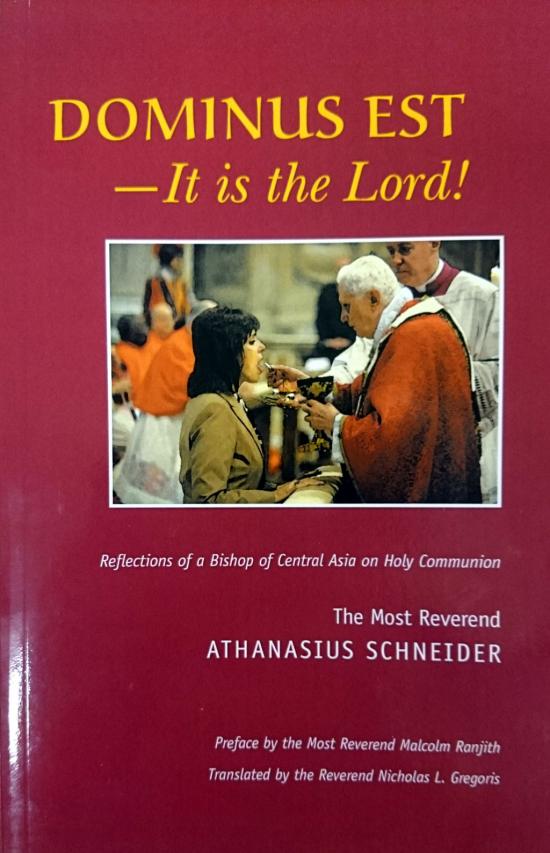Dominus Est - It is the Lord!
Dominus Est is a plea of Bishop Athanasius Schneider for the worthy administration of Holy Communion.
The following review of this title originally appeared in the German language newspaper 'Die Tagespost' in 2009.
Drawing from the Treasures of the Church, review by Manfred Hauke
In his Apostolic Letter on the Eucharist Pope Benedict XVI recalls the words of St. Augustine: “But no one eats that flesh without first adoring It; we should sin were we not to adore It” (Enarrationes in Psalmos 98:9: Sacramentum Caritatis 66). Indeed the adoration of the eucharistic Christ belongs to the core of the Catholic Faith, and it must also be expressed in the liturgy. A small book by auxiliary bishop Athanasius Schneider of Karaganda (Kazakhstan) is dedicated to this wish, a book which has already aroused great notice in the Italian original edition that appeared last year from the Libreria Editrice Vaticana. The cover image shows Pope Benedict XVI as he brings Holy Communion to the mouth of a girl making her first Communion, kneeling in recollection and with hands folded. This practice is common now in papal Masses, at least for the faithful who receive Communion from the Holy Father personally. It is a reminder that Communion by mouth remains the universal norm of the Church, even in the reformed liturgy of Pope Paul VI, and that Communion in the hand has only been allowed additionally on a regional basis, with specific conditions. In view of the spread of Communion in the hand, almost worldwide by now, the stance of Pope Benedict XVI and the publication of the work which lies before us is almost a sort of liturgical revolution, as Archbishop Malcolm Ranjith, the present secretary of the Congregation for Divine Worship and Discipline of the Sacraments, states in an extensive foreword (pp. 7-12) [preface, pp. 13-17]
This small but content-rich book does not present any argument that would reject the current practice of Communion in the hand on principle, but impressively shows important historical, liturgical, dogmatic, and pastoral reasons for the kneeling reception of Communion by mouth. The present-day practice of Communion in the hand is different from the usage of the early centuries of Christianity: according to the exemplary witness of Cyril of Jerusalem, the Eucharist was received with the right hand and then taken up by mouth (pp. 36ff) [pp. 34ff]. This was to ensure that no particles would be lost (pp. 36-42) [pp. 34-38]. Besides this circumspection, adoration is also important: if the faithful are to kneel at the eucharistic consecration as a sign of adoration, the author asks, how fitting is it to recommend the standing reception of Communion in the hand? (p. 63) [p. 50] It is admittedly not quite correct, as Schneider points out, that the Church “prescribes” kneeling at the consecration, but at least the latest 2002 edition of the Roman Missal recommends this posture, as does the post-synodal Apostolic Letter on the Eucharist, Sacramentum Caritatis (2007, n. 65).
In a first section, Bishop Schneider tells of the “eucharistic women” in Kazakhstan, who, while the Church was under persecution, maintained the adoration of the Sacrament of the Altar at the cost of great personal sacrifice (pp. 13-22) [19-26]. The faith and reverence of these faithful, which so impressed the author, are indeed exemplary. The second part of the work presents “some historical-liturgical observations on Holy Communion” (pp. 23-60) [pp. 26-48] with a diligently prepared collection of texts from Church Fathers who are also highly regarded in the Orthodox Church. The author does not go into all the points of view discussed in liturgics regarding the reception of Communion, but still sets forth a convincing plea to rediscover the adoration of the eucharistic Lord and childlike reverence for the Sacrament of the Altar by means of Communion by mouth, received kneeling. The title of the work, “Dominus Est” -- “It is the Lord”, is a quotation from the Gospel of St. John: with these words the beloved disciple John points out to St. Peter the risen Christ, who appears to His own (Jn 21:7). Whoever believes in the bodily presence of the resurrected Lord in Holy Communion will be happy to share the author's conclusion: the house of God, the Church, can only be renewed when she places the eucharistic Jesus at the center, and acts “so that in the moment of Holy Communion a sign of reverence and adoration is also included.” (p. 64) [p. 51]
Paperback, 64 pages.






